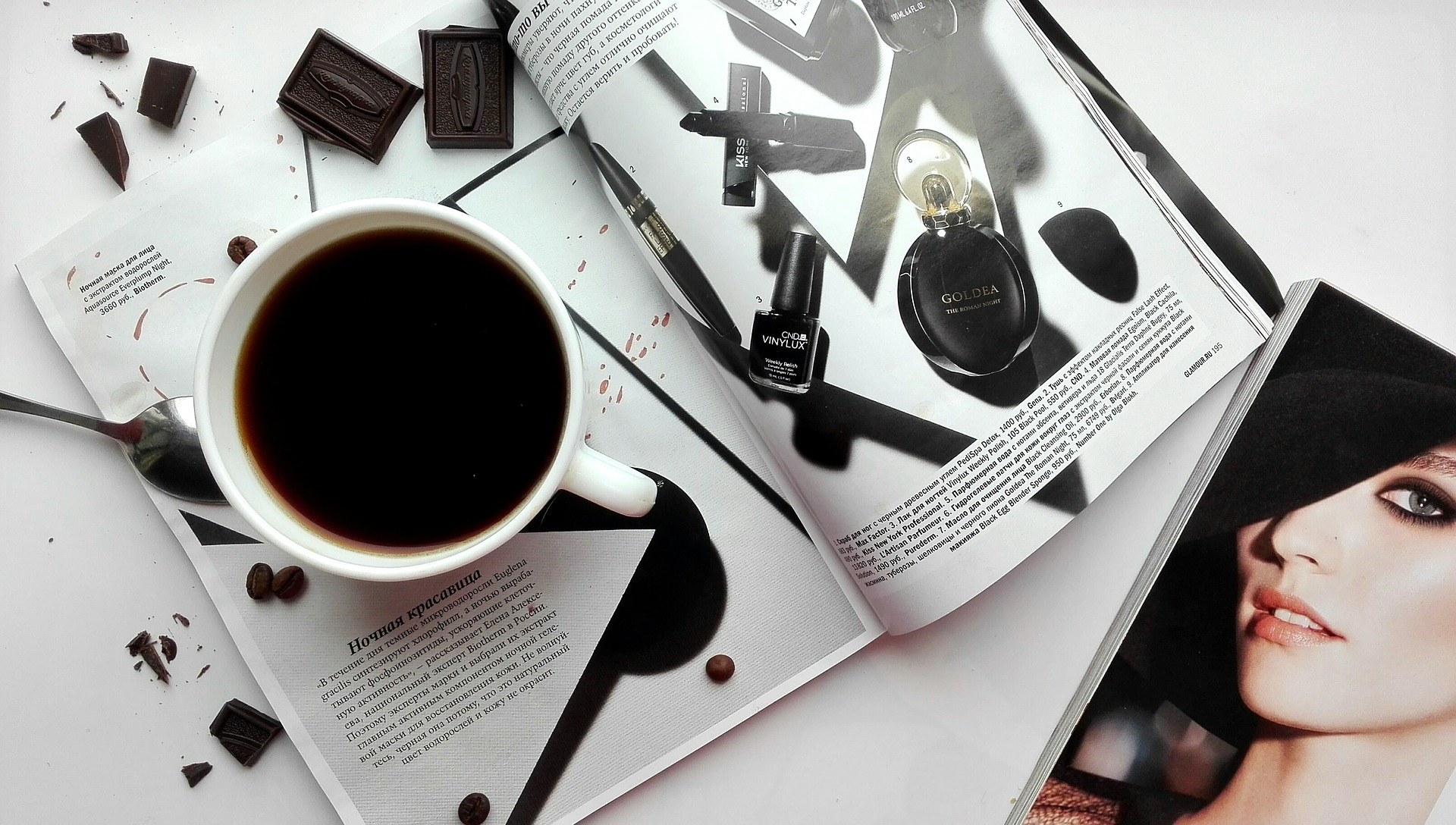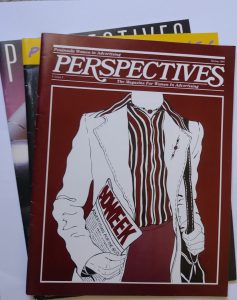
It’s been fun reading the other stories and remembering all the wonderful magazines we read. Alas, so many are gone! As I looked at old magazine covers online for this story, it struck me how “prescriptive” all the magazines for teenage girls were. Wear this, do your hair and makeup like this, interact with boys this way … It seemed normal back then.
These teen-girl publications lacked content for nerdy girls like me, though.
By the time I was about 10 I was reading Teen, then quickly graduated to Seventeen, which had better articles and clothes. By 12 I’d reached my current height and weight and needed adult clothing anyway, so this was appropriate. When I was in high school I switched to Glamour. By reading this magazine, a girl could anticipate college life, supposedly. I did bond with my mom by reading with her the “back to college” issue that came out in August, I believe. This tome was about the size of the Sears catalog and contained all the latest trends in fashion, makeup, and hairstyles for the coming fall. My mom liked it because, as a textile designer and expert seamstress, she was sincerely interested in clothes.
These teen-girl publications lacked content for nerdy girls like me, though. At least Glamour had the “top 10 college girls,” and I believe it was Mademoiselle (which I didn’t read) that had young women as guest editors, the most famous of whom was Sylvia Plath.
All through my childhood I loved Mad and read it with my dad, and later, when he was old enough, with my younger brother. What a refreshing contrast to the girls’ magazines. The usual gang of idiots was so clever and had a lot of freedom, and the anarchy was preferable to all the rules that the girls’ magazines had. There was even, for a while, the Mad Game, an actual board game. I remember playing it at my Uncle Julian’s house with him, my dad, and my cousin Steve, and we were convulsed with laughter. My Aunt Ruth, a lovely person but completely lacking a wacky sense of humor, stared at us tight lipped the whole time and finally walked out of the room in a huff.
By college my time was taken up with so much reading that I temporarily abandoned most magazines. However, it was very exciting when Ms. came out. Finally, “serious” articles that weren’t about what we looked like. I enjoyed Ms. for many years, and later, when I started working, a magazine called Savvy, which had articles for women trying to advance their careers in what was very much a man’s world.
At about that time, I became involved with a local women in advertising group in San Francisco and, when I moved to the Peninsula, was a founding member of the women in advertising group there. Many of us faced challenges getting ahead because we were denied opportunities to learn the skills and have the experiences that would help us. Trade publications still were running help wanted men and help wanted women ads separately. So, we began teaching each other so we would have projects to put in our portfolios and on our resumes.
One of the outcomes was Perspectives, an annual magazine that had articles about women’s experience in high-tech communications. We wrote, edited, and designed it ourselves for six years. It was rewarding to see our own perspectives in print. Kudos to Bev, one of my oldest friends who I still see often (now virtually), who designed the cover for the first issue pictured at the right.
These days I get Hadassah, AARP, and Science magazine in print, and I look forward to them. Hadassah and AARP do cover health (although not exactly beauty), but don’t seem as prescriptive as those girl magazines of the 60s. However convenient online publications are, I still relish the IRL experience that comes with holding a magazine.
I have recently retired from a marketing and technical writing and editing career and am thoroughly enjoying writing for myself and others.




Marian, I love your take on magazines, past and present. You are so right about how magazines for girls were always prescriptive! You have to look and act this way. This was still true when my daughters read them, so things haven’t changed as much as we think (or hope).
I knew we shared a love of Mad Magazine, but I never knew there was a board game too. I bet that would still be fun to play! And thanks for mentioning Ms. Magazine, I read that religiously for years, don’t know how I could forget to write about it! Finally, that Perspectives magazine is very impressive, and the first cover is gorgeous! Would love to see later covers too. Thanks for sharing your insights!
P.S. I just found this article describing the Mad Magazine Game in detail, and now I’m dying to play! https://en.wikipedia.org/wiki/The_Mad_Magazine_Game
Glad you found the Mad magazine game, Suzy. I feared it had disappeared into the dust of the past. It’s unfortunate, but not surprising, that the magazines for girls are still prescriptive. I am missing a couple of issues of Perspectives but I can send you photos of the other two that are covered by the first issue. We had a lot of professional designers in the group itching to go to the next level, so the work was rewarding to everyone.
Love the feminist take on the prompt, Mare! We hardly stood/stand a chance with that diet, but we persevere! I especially love that you were part of a team that produced Perspectives…that cover is beautiful! I’m a closet graphic designer and feel like I really missed the boat on that one. I’d love to see other covers as well!
Thanks, Barb, it was so much fun working with a group of wonderful women on the magazine. We even had a reunion last summer and about 30 people made it. We simply picked up where we left off and it seemed as if no time went by! I will send the admins photos of the other covers. I’m disappointed that somehow the others vanished, but so it goes.
As I read your story, I realized that I never read magazines as a kid. I didn’t read the girl magazines that you describe, and only occasionally picked up Mad Magazine. So reading your story gave me some insight into myself. No Tiger Beat for me!
Your professional magazines and group of friends sound interesting. It’s great that you’ve stayed in touch all these years too.
Thanks, Betsy. Interesting that you didn’t read those magazines. I think I did partially so that I could feel like the “average” American girl, but of course that didn’t work. I’m very grateful for the lifelong friends I’ve made from the advertising group. We have seen so much progress in that field. Not that everything is perfect, but we’ve made great strides from where we started.
Marian, you make a very good point about all of the magazines marketed for girls that we devoured in our youth. The focus on appearance and low career expectations helped to promote the limited career choices that seemed to be available to us. Ms Magazine was a breath of fresh air. Perspectives looks interesting. Anything that stops focusing on clothing and makeup.
It’s good to have a full range of options, Laurie. While I don’t have anything against fashion, it shouldn’t be the whole story. Before the pandemic I used to enjoy reading Vogue at the salon when I was having my hair colored. That will no longer happen.
As a guy (with only a brother), I particularly enjoyed and appreciated your take on girl’s magazines, since, other than their titles, I had scant knowledge of them growing up. And, as other of the women writers have also noted, it is fascinating — though not in a good way — that they were all so prescriptive. And not in any very progressive way.
Conversely, as I think of it, Mad was zanily anti-prescriptive, tacitly encouraging its readers to break, or at least ignore, all the stupid rules. Much healthier, right?
Incidentally, did any girls/women actually read Cosmopolitan? Based on my limited knowledge, it was not nearly so prescriptive — to the contrary, the message was “Do it!” — but the “it” that Helen Gurley Brown seemed to be encouraging was itself pretty retrogade — like dressing provocatively and having wild sex so that that cool, rich guy will want to marry you.
Not too many girls/women I knew read Cosmo, John, so hard to say. For many of us, it was as unrealistic as the other mags, just in a different way. I like your term “retrograde.” I remember the biggest difference between college women and men was in relation to the Playboy type publications. At Mills, someone brought in an issue of Playgirl to one of our English classes, and we enjoyed it, although poor Miss Pope, our professor, was a bit shocked. However, we soon became bored with it and didn’t read subsequent issues. That’s why it went out of business!
My favorite magazine was Boys Life which I grabbed before my brother had a chance to read it. I won my junior high science fair by building an electronic organ using a schematic I found in the magazine. The only girly thing I was interested in was clothes, so I did sometimes buy Seventeen or Glamour, but my favorite was Vogue. I was really disappointed when I arrived at college to find the girls wore nothing but blue jeans and muddy tie-dyed shirts.
Fantastic coup, Cynthia. I always wondered what was in Boys Life. I had a similar experience going to college. No one work makeup, just jeans and t-shirts.
Hi Marian, I was fascinated by your mention of a women in advertising group in San Francisco and the peninsula. Around 1978 or 1979, I was living in San Francisco and founded an organization called the Bay Area Professional Women’s Network. I reached out to every other organization I could find like Women Engineers. I can’t remember if I found the advertising group. At the time, networking was a new idea and some women didn’t like the fact that I used the word in the name of the group. Now of course, it is much overused. We had more than 300 members at one point, then I moved to Tahoe and the group faded away a few years later.
Amazing coincidence, Cynthia. Yes, San Francisco Women in Advertising was around between about 1976 and into the 80s. I moved to the Peninsula in 1978 and shortly thereafter a group of us, who had been going to San Francisco, founded Peninsula Women in Advertising. I lost touch with the San Francisco group after that.
Marian, brava on founding Perspectives, what an achievement!
I confess I’ve never read the AARP magazine – perhaps I’ve been in denial about my advanced age?!? But you seem to like it, shall I reconsider?
Thanks, Dana. Yes, AARP magazine has changed a lot and has a lot of good articles for grownups, not old codgers. While it isn’t my favorite publication, it’s worth a read.
Thanx M, will try to find some time to read it in my current very busy schedule!